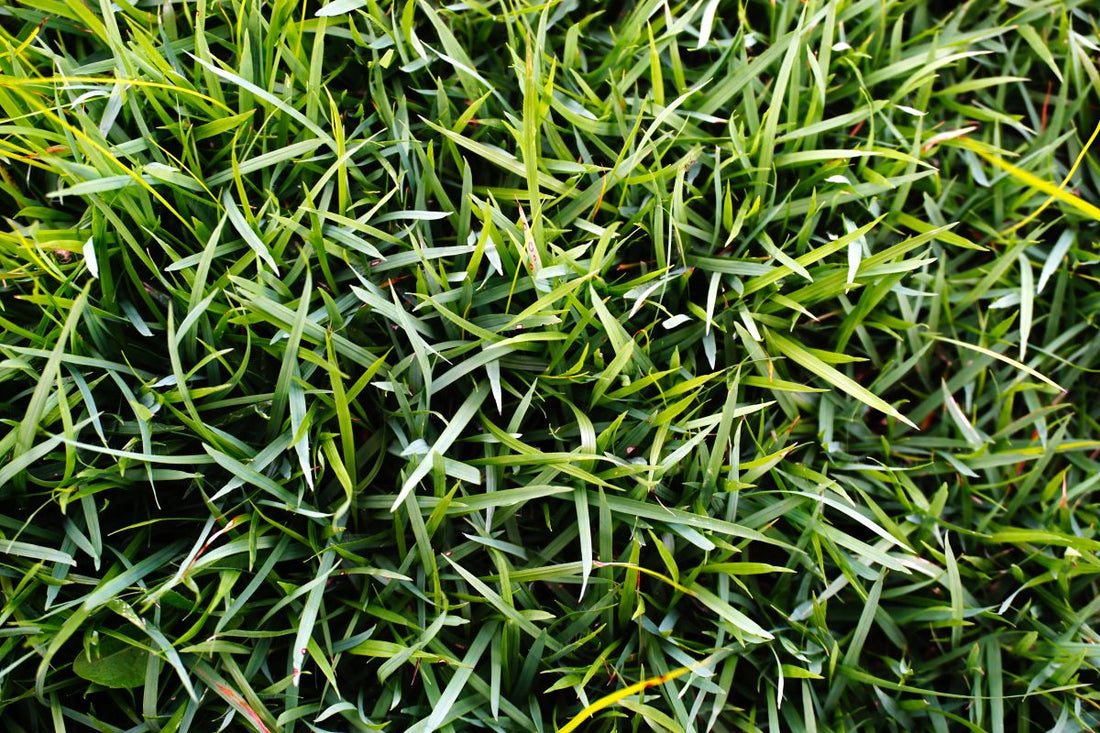Zoysia is one of the most durable warm-season grasses you can grow, prized for its dense turf, drought tolerance, and ability to handle heavy foot traffic.
But like other warm-season grasses, Zoysia goes dormant in cooler months, leaving a brown or straw-colored lawn through fall and winter. For homeowners who want green curb appeal all year, the best solution is overseeding zoysia grass with ryegrass.
Homeowners who follow the right timing, seed selection, and preparation steps enjoy a lawn that looks professionally maintained even in the dormant season. This guide provides a step-by-step breakdown of how to do exactly that.
What this article covers:
- Why Overseed Zoysia Grass?
- Best Time to Overseed Zoysia Grass
- Choosing the Right Seed for Overseeding Zoysia
- Preparing Your Zoysia Lawn for Overseeding
- Step-by-Step Process for Overseeding Zoysia
- Transitioning Back to Zoysia in Spring
Why Overseed Zoysia Grass?
Overseeding Zoysia doesn't mean adding more Zoysia seed, since it germinates too slowly to provide seasonal coverage. Instead, homeowners overseed with ryegrass, a fast-germinating cool-season grass that stays green while Zoysia rests.
Maintain Winter Color
The main reason homeowners overseed Zoysia is to avoid the brown, dormant look. Ryegrass germinates quickly, covers evenly, and stays green all winter, then naturally declines as Zoysia reawakens in spring.
Fill Bare or Thin Areas
If your Zoysia has been stressed by drought, pests, or heavy wear, overseeding can fill in weak areas. In our experience, overseeding with ryegrass helps lawns maintain density and recover faster when warm weather returns.
Suppress Winter Weeds
Dormant Zoysia leaves bare soil exposed, which is an open invitation for weeds. Overseeding with ryegrass creates competition, shading the soil and reducing weed pressure during the cool season.

Best Time to Overseed Zoysia Grass
Timing is critical for overseeding success. Plant ryegrass too early, and seedlings struggle in lingering summer heat. Seed too late, and frost prevents germination.
- Early Fall (September–October): The best time to overseed Zoysia is when soil temperatures reach 65–70°F. This window allows ryegrass to germinate quickly while Zoysia is slowing down.
- Too Early: Overseeding in late summer exposes ryegrass to heat stress. We've noticed this often leads to poor survival or burned seedlings.
- Too Late: If frost arrives before germination, the seed will sit dormant and never establish.
Spring overseeding isn't recommended because ryegrass competes directly with actively growing Zoysia. Instead, use spring to fertilize and strengthen your Zoysia base, not to introduce new cool-season seed.
Choosing the Right Seed for Overseeding Zoysia
One of the most common points of confusion for homeowners is whether overseeding Zoysia means adding more Zoysia seed.
The reality is that Zoysia seed germinates very slowly – often taking three to four weeks just to sprout – and does not establish quickly enough to provide winter coverage.
For that reason, overseeding Zoysia always involves using ryegrass as a temporary cool-season companion.
- Perennial ryegrass: The best option for most homeowners. It produces a dark green color, fine leaf texture, and consistent coverage through the dormant season. It blends seamlessly with Zoysia, then dies back naturally as the soil warms in spring.
- Annual ryegrass: A more affordable choice that germinates quickly, but its lighter color, coarser texture, and shorter life span make it less appealing for long-term curb appeal. It often thins before Zoysia fully greens up.
At Lawn Synergy, we recommend professional overseeding seed options in our Grass Seed Collection that provide predictable, professional results.

Preparing Your Zoysia Lawn for Overseeding
Preparation is just as important as timing. Without proper prep, ryegrass seed won't make solid contact with soil, and germination will be inconsistent.
- Mow Zoysia Short (1–1.5 inches): Scalp Zoysia low and bag clippings. A shorter cut opens up the canopy and allows the seed to reach the soil.
- Dethatch and Aerate: Zoysia tends to form a dense thatch layer. Dethatching and core aeration are non-negotiable for seed-to-soil contact. Aeration also improves water and nutrient movement into the soil.
- Test and Balance Soil: Cool-season ryegrass performs best in soil with a pH of 6.0–7.0. Use a soil test kit to check levels. If compaction is an issue, apply gypsum soil conditioner to improve structure.
- Apply Starter Fertilizer: A balanced starter such as Starter Fertilizer 15-20-10 provides phosphorus for strong roots and iron for early color. Unlike filler-heavy products, Lawn Synergy fertilizers are enriched for real results.
Step-by-Step Process for Overseeding Zoysia
Follow these steps carefully for a professional-grade overseed. In our experience, skipping even one step can result in patchy germination and wasted effort.
1. Mow and Dethatch
Cut Zoysia down to 1–1.5 inches before seeding. Bag clippings so they don't block seed-to-soil contact. If your lawn has more than half an inch of thatch, use a dethatching rake or machine to remove it.
We've noticed that homeowners who skip this step often see ryegrass sprouting in clumps instead of creating uniform winter cover.
2. Aerate Compacted Soil
Run a core aerator across the lawn, especially in high-traffic zones where Zoysia is often compacted. The aeration holes serve as seed pockets, holding ryegrass seed in place while improving water and nutrient movement.
This step is just as important here as it is when overseeding Bermuda grass or overseeding centipede grass, because all warm-season grasses develop compaction issues over time.

3. Spread Ryegrass Seed Evenly
Broadcast ryegrass seed at a rate of 5–10 pounds per 1,000 square feet. Use a calibrated rotary spreader and make two passes at right angles to avoid stripes or thin spots.
For bare areas, overseed slightly heavier by hand. Consistent coverage is the difference between a lush green winter lawn and one that looks patchy and uneven.
4. Apply Starter Fertilizer
Apply a starter fertilizer immediately after spreading seed. A balanced product like Starter Fertilizer 15-20-10 supplies phosphorus for root growth and iron for a strong green color.
5. Water Lightly and Consistently
Moisture management makes or breaks overseeding. Mist the lawn lightly two to three times per day until ryegrass sprouts, usually within 7–10 days.
Once seedlings reach about one inch tall, reduce frequency and water more deeply to encourage root development. Avoid heavy watering early on, which can wash seed into clumps or puddles.
We've noticed that when homeowners scalp, dethatch, aerate, and fertilize correctly, ryegrass almost always grows back within a week and covers the winter lawn completely in three weeks.
Transitioning Back to Zoysia in Spring
Overseeded ryegrass is temporary, and the transition back to Zoysia must be managed carefully.
As soil temperatures climb into the 60s, slowly lower your mower height. This stresses ryegrass while exposing Zoysia stolons to more light.
Avoid fertilizing ryegrass in spring. This encourages ryegrass to fade, allowing Zoysia to regain dominance.
Once soil temperatures consistently exceed 70°F, Zoysia reawakens and spreads aggressively. Ryegrass naturally dies out in the heat, leaving your warm-season lawn intact.
Conclusion
A Zoysia lawn is one of the most durable warm-season choices, but dormancy can leave it looking lifeless for months.
Overseeding zoysia grass with ryegrass bridges that gap, keeping your yard green, functional, and weed-free year-round.
At Lawn Synergy, we've overseeded lawns across Florida, North Carolina, and beyond. Our 30+ years of estate care experience, combined with professional-grade lawn fertilizer and grass seed, give DIY homeowners everything they need to succeed.
Ready to learn more about lawn care? Check out these articles:

